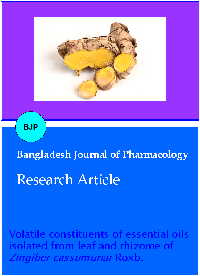Volatile constituents of essential oils isolated from leaf and rhizome of Zingiber cassumunar Roxb.
DOI:
https://doi.org/10.3329/bjp.v3i2.844Keywords:
Essential oil composition, GC-MS, Sabinene, Triquinacene, 1, 4-bis (methoxy), Zingiber cassumunarAbstract
The composition of the essential oil of Zingiber cassumunar Roxb. from Bangladesh was examined by gas chromatography mass spectroscopy (GC-MS).Sixty-four components were identified in leaf oil and 32 components were identified in the rhizome oil, accounting for 94.60% and 98.56% of the total yields, respectively. The main component in leaf oil was sabinene (14.99%), b-pinene (14.32%), caryophyllene oxide (13.85%) and caryophyllene (9.47%). On the other hand, rhizome oil contained triquinacene 1,4-bis (methoxy) (26.47%), (Z)-ocimene (21.97%) and terpinen-4-ol (18.45%). The compositions of both oils varied qualitatively and quantitatively.
Downloads
497
669 Read
105
References
Bin JI, Mohd YMS, Chin CB, Sim NL. Antifungal activity of the essential oils of nine Zingiberaceae species. Pharm Biol. 2003; 41: 39297.
Giwanon R, Thubthimthed S, Rerkam U, Sunthorntanasart T. Antimicrobial activity of terpinen-4-ol and sabinene. Thai J Pharm Sci. 2000; 24(Suppl): 27.
Habsah M, Amran M, Mackeen MM, Lajis NH, Kikuzaki H, Nakatani H, Rahman A, Ghafar A, Ali AM. Screening of Zingiberaceae extracts for antimicrobial and antioxidant activities. J Ethnopharmacol. 2000; 72: 403-10.
Jeenapongsa R, Yoovathaworn K, Sriwatanakul KM, Pongprayoon U, Sriwatanakul K. Anti-inflammatory activity of (E)-1-(3,4-dimethoxyphenyl) butadiene from Zingiber cassumunar Roxb. J Ethnopharmacol. 2003; 87: 143-48.
Jitoe A, Masuda T, Mabry TJ. Novel antioxidants, cassumunarin A, B, and C from Zingiber Cassumunar. Tetrahedron 1994; 35: 981-84.
Kanjanapothi D, Soparat P, Panthong A, Tuntiwachwuttikul P, Reutrakul V. A uterine relaxant compound from Zingiber cassumunar. Planta Med. 1987; 53: 329-32.
Kishore N, Dwivedi RS. Zerumbone: A potential fungitoxic agent isolated from Zingiber cassumunar Roxb. Mycopathologia 1992; 120: 155-59.
Kuroyanagi M, Fukushima S, Yoshihira K, Natori S, Dechatiwongse T, Mihashi K, Nishi M, Hara S. Further characterization of the constituents of a Thai medicinal plant, Zingiber cassumunar Roxb. Chem Pharm Bull. 1980; 28: 2948-59.
Masuda T, Jitoe A. Antioxidative and antiinflammatory compounds from tropical gingers: Isolation, structure determination, and activities of cassumunins A, B, and C, new complex curcuminoids from Zingiber cassumunar. J Agric Food Chem. 1994; 42: 1850-56.
Oliveros MB. Preformulation studies on terpinen-4-ol from Zingiber purpureum Rosc. In: Proceedings of the 2nd Symposium on the Family Zingiberaceae. Wu TL, Wu QG, Chen ZY (eds). Guangzhou, Zhongshan University Press, 1996, pp 180-86.
Ozaki Y, Kawahara N, Harada M. Anti-inflammatory effect of Zingiber cassumunar Roxb. and its active principles. Chem Pharm Bull. 1991; 39: 2353-56.
Panthong A, Kanjanapothi D, Niwatananant W, Tuntiwachwuttikul P, Reutrakul V. Anti-inflammatory activity of compound D {(E)-4-(3?,4? dimethoxyphenyl) but-3-en-2-ol} isolated from Zingiber cassumunar. Phytomedicine 1997; 4: 207-12.
Panthong A, Kanjanapothi D, Niwatananun V, Tuntiwachwuttikul P, Reutrakul V. Anti-inflammatory activity of compounds isolated from Zingiber cassumunar. Planta Med. 1990; 56: 655.
Piromrat K, Tuchinda M, Geadsomnuig S, Koysooko R. Antihistaminic effect of "Plai" (Zingiber cassumunar Roxb.) on histamine skin test in asthmatic children. Siriraj Hosp Gaz. 1986; 38: 251-56.
Pongprayoon U, Tuchinda P, Claeson P, Sematong T. Topical antiinflammatory activity of the major lipophilic constituents of the rhizome of Zingiber cassumunar. Part 1. The essential oil. Phytomedicine 1997; 3: 319-22.
Pongprayoon U, Tuchinda P, Claeson P, Sematong T, Reutrakul V. Topical anti-inflammatory activity of lipophilic constituents of the rhizome of Zingiber cassumunar. Part 2. Hexane extractives. Phytomedicine 1996; 3: 323.
Tripathi P, Dubey NK, Shukla AK. Use of some essential oils as post-harvest botanical fungicides in the management of grey mould of grapes caused by Botrytis cinerea. World J Microb Biotech. 2008; 24: 39-46.
Taroeno JJ, Brophy JH, Zwaving. Analysis of the essential oil of Zingiber cassumunar Roxb. from Indonesia. Fla Fra J. 1991; 6: 161-64.
Tuntiwachwuttikul P, Limchawfar B, Reutrakul VPO, Kusamran K, Byrne LT. Syntheses of some constituents of Zingiber cassumunar. Aust J Chem. 1980; 33: 913-16.
Tuntiwachwuttikul P, Pancharoen O, Jaipetch T, Reutrakul V. Phenylbutanoids from Zingiber cassumunar. Phytochemistry 1981; 20: 1164-65.
Wasuwat S, Wanisorn P, Mahintorntep B, Kuwaono K, Sanghirun S. Studies on antimicrobial and antifungal activities of terpinen-4-ol extracted from Zingiber cassumunar Roxb. Thailand Institute of Scientific and Technological Research 1989, Research Project No. 30-32/Rep. No.1 (In Thai).

Additional Files
Published
How to Cite
Issue
Section
License
Authors who publish with this journal agree to the following terms:
- Authors retain copyright and grant the journal right of first publication with the work simultaneously licensed under a Creative Commons Attribution License that allows others to share the work with an acknowledgement of the work's authorship and initial publication in this journal.
- Authors are able to enter into separate, additional contractual arrangements for the non-exclusive distribution of the journal's published version of the work (e.g., post it to an institutional repository or publish it in a book), with an acknowledgement of its initial publication in this journal.
- Authors are permitted and encouraged to post their work online (e.g., in institutional repositories or on their website) prior to and during the submission process, as it can lead to productive exchanges, as well as earlier and greater citation of published work (See The Effect of Open Access).
